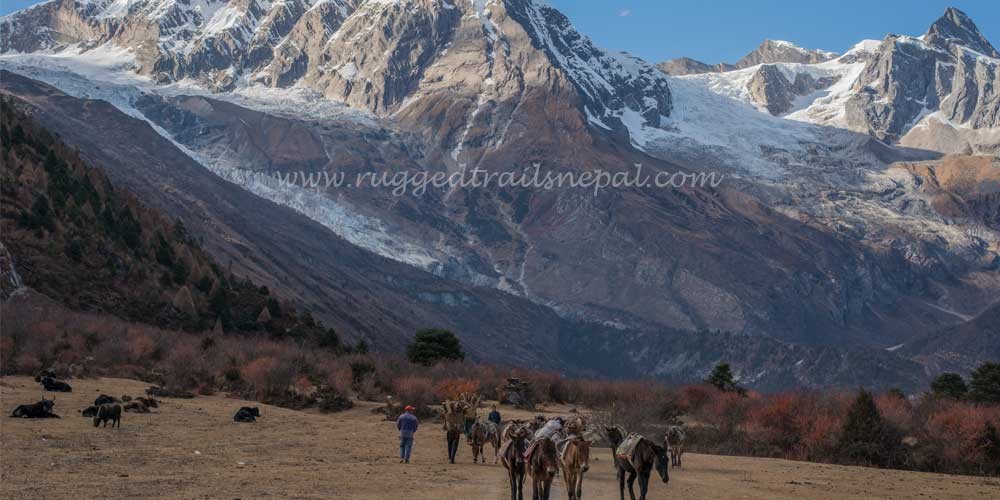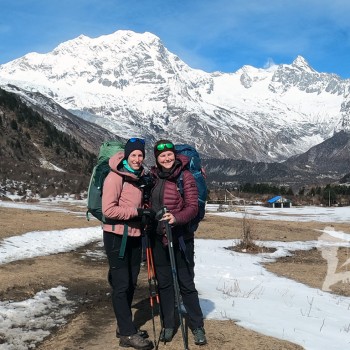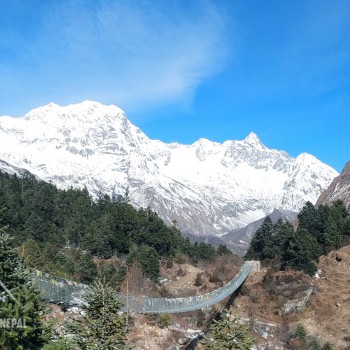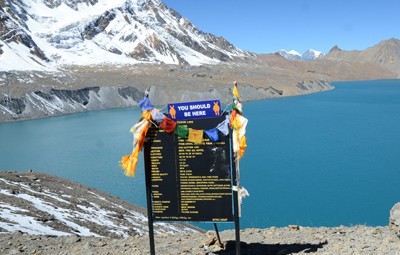The Manaslu Circuit Trekking is one of the very best treks in Nepal. Almost unheard of by most visitors to the country, it is a hidden gem and will blow you away with its raw beauty. The trip around Manaslu (8156 meters / 26,758 feet) is a challenging one, though exceptionally rewarding for those who brave the path. Stay in beautiful villages, cross suspension bridges over rushing rapids, and traverse high passes in this adventurous trek.
The Manaslu Circuit Trek joins the Annapurna region with the Manaslu region, and you truly get the best of both. Many guides say the trail is comparable to the Annapurna Circuit Trek but with fewer tourists. The amazing scenery never stops. From the forests, teeming with life at the beginning of the trail, to the barren, rocky landscape above the clouds, you will constantly be in awe. Free your mind for a bit on the Manaslu Circuit Trekking. Your biggest worry will be, ‘Where is the next best view?’
Manaslu Circuit Trekking Highlights
- World Heritage Sites Visit in Kathmandu.
- Scenic drive and a short hike on the world’s best trek trail, Annapurna Circuit.
- Exploring rivers, waterfalls, and landscapes.
- Typical Nepalese lifestyle, Tibetan Buddhism, and monasteries.
- Amazing Mt. Manaslu and the other Himalayas.
After hopping out of the car, the beauty of Manaslu greets us. Pass through Gurung and other ethnic villages and experience their warm hospitality. Because so few trekkers take the Manaslu Circuit Trek, we are welcomed with open arms. There is a saying, ‘Guest is God,’ and in these areas, the residents truly practice this phrase.
As we climb higher and move closer to the Tibetan border, the population is nearly all ethnically Tibetan, and a different language is even spoken. It does not take long to realize that half of the appeal of trekking in the Himalayas goes beyond mountain views. The rich culture of the hills and mountains is invaluable. You will look at your own life differently after spending a few weeks in the various teahouses and homestays along the trail.
Beginning from Soti Khola (700 meters), the trail is almost a continuous climb up the Budhi Gandaki River. At certain points, we must zig-zag up the vertical cliffs that guide the river. The area is home to a number of wild animals, including the musk deer, and even the snow leopard higher in the alpine territory.
At last, we reach the Larkya La (pass). At 5135 meters / 16,847 feet), it’s the highest point of our trek as well as the most mesmerizing for most people. To reach it, we walk by four frozen lakes. At the top, feast your eyes on Himlung Himal (7126 meters), Cheo Himal (6820 meters), Gyaji Kung (7030 meters), Annapurna II (7937 meters), and many rugged peaks. It’s a moment you’ll never forget! From here, we descend to Dharapani and then to Besisahar. Soon, we’ll be back in Kathmandu for the farewell dinner.
What is the best time of year to do the Manaslu Circuit Trek?
- Autumn/Fall
In Nepal, September through November are the ideal times to go hiking. With bright sunny days and great visibility, the weather is dry and clear. Additionally, because there are fewer chances of weather-related natural disasters, this is the safest time to go trekking.
The price of the Manaslu Restricted Area Permit (RAP) during this season is a disadvantage of the Manaslu Trek. The RAP generally costs $75 per week; however, during the busiest times, the price jumps to $100 per week. This is the busiest trekking season in Nepal, so the routes are also busier at this time.
- Spring Season
The second-best option is said to be the spring season, which runs from March to May. In general, the sky is clear, although it is a little chilly, especially at higher elevations. Flowers are in bloom, and the mornings are sunny. However, there is a higher probability of snow.
- Summer Season
The Manaslu Circuit Trek should be avoided from June to August. The monsoon season brings warm and humid weather, as well as poor visibility due to clouds and mist. There is a high risk of landslides on the Manaslu trail, and leeches are also a major problem during this time of year. Although we have successfully completed numerous treks during this time, we still recommend that you change your plans to a location with less risk of landslides, such as Langtang or the Annapurna region.
- Winter Season
Higher altitudes experience freezing temperatures from December to February. Due to snow and ice, this time of year is not suitable for the Manaslu Circuit Trek. We do not organize Manaslu treks, Everest High Passes, or other high-mountain adventures during this time. If you are still interested in trekking, we recommend lower-elevation treks such as those in the Annapurna region, the Kathmandu Valley Rim trek, etc.
How difficult do trekkers find the Manaslu Circuit Trek?
Some people describe the Manaslu Circuit Trek as being difficult, strenuous, and hard. The trails are in good condition and do not require any technical skills. However, the trails can be difficult depending on the time of year, such as during landslides or heavy snowfall. The trail is also a bit slippery, so extra care is needed. The most important thing is your effort. You will ascend in altitude from 700 to 5106 meters. There will be ups and downs, river crossings, and more ascending. This process clearly indicates that physical effort is required. You must be fit, but you do not need to be an athlete or a professional trekker. People of all ages can complete the Manaslu Circuit Trek, as long as they are physically fit and keep their pace while walking. If you choose to carry all your own gear, clearly it will be more challenging. That's why we arrange for Porters to carry your gear, and you just need to carry your personal things such as wallets, cameras, and water for the day. Clearly, the Manaslu circuit trekking package is not for beginners.
How long does the Manaslu circuit trek take?
The Manaslu Circuit Trek can be as short as 12–13 days, but you will need to be in good shape and prepared for a long walk. We recommend a 16-day itinerary, which allows you to acclimatize to the altitude and enjoy the scenery.
Many local trekking companies offer shorter itineraries, but they do not include the time required to obtain the necessary permits. The Manaslu Circuit Trek is a restricted area trek, so you will need to obtain a special permit from the Nepal government. This process can take up to one full day, so it is important to factor this into your itinerary.
If you are planning to do the Manaslu Circuit Trek, we recommend sticking with a 16-day itinerary. This will give you enough time to acclimatize to the altitude, explore the region, and enjoy the stunning scenery. If you have more time, you can always extend your trip.
Benefits of a 16-day Manaslu Circuit Trek itinerary:
- More time to acclimatize to the altitude: This is important to avoid altitude sickness.
- More time to explore the region: There are many beautiful villages, monasteries, and temples to see on the Manaslu Circuit Trek.
- More time to enjoy the scenery: The Manaslu Circuit Trek is one of the most scenic treks in the world.
What permits do I need for the Manaslu Circuit Trek in 2025?
To trek in the Manaslu region, you must obtain three different permits issued by the government of Nepal. You must travel with a government-approved trekking company because the Manaslu region is a restricted area. You must also have two people to obtain the Manaslu Restricted Area Permit.
The Department of National Parks and Wildlife Conservation in Kathmandu is responsible for issuing the Manaslu Conservation Area Project (MCAP) permit. The Department of Immigration in Pokhara and Kathmandu is responsible for issuing the Manaslu Restricted Area Permit (RAP). As the Manaslu trail ends in the Annapurna Conservation Area, the Department of National Parks and Wildlife Conservation in Kathmandu is responsible for issuing the Annapurna Conservation Area (ACAP) permit.
The fees for the trekking permits vary depending on your nationality and the time of year you are trekking. The Manaslu trek permit from September to November (autumn) will cost USD 100 for the first seven days and USD 15 for each additional day. The Manaslu trek permit from December to August (winter, spring, and summer) will cost USD 75 for the first seven days and USD 10 for each additional day. From 2024 Autumn, there is another additional fee added for Manaslu Circuit Trek, which is 1000 rupees for foreigners and 200 rupees for Nepalese trekkers. The additional fees will be collected by the Chumnubri Rural Municipality after entering the Manaslu Conservation Area.
The Manaslu Conservation Area Permit Fee is as follows:
- SAARC nationals: NRs. 1,000 per person
- Other nationals: NRs. 3,000 per person
The Annapurna Conservation Area Permit Fee is as follows:
- SAARC nationals: NRs. 1,000 per person
- Other nationals: NRs. 3,000 per person
To obtain the Manaslu Restricted Area Permit (RAP), you must show your original passport to the Department of Immigration. You will also need to provide three passport-sized photos. Rugged Trails Nepal will arrange for the other documents, such as the trek itinerary, official documents from the trekking company, and copies of current staff insurance.
What gear do I need for the 16-day Manaslu Circuit Trek?
This Manaslu Circuit is a teahouse trek, so you don't need much specialist gear or equipment. We won't need to carry food, as this is a teahouse trek. However, there are a few essential items. Please follow the link to get an idea of the trekking gear you will need.
What are the dangers of the Manaslu Circuit Trek?
Altitude sickness is a major concern for trekkers on any high-altitude trek, including the Manaslu Circuit Trek and the Everest Base Camp Trek. The 16-day Manaslu Circuit Trek itinerary allows for acclimatization days, but it is still important to consult with your doctor if you are considering taking preventative medication like Diamox. You should also have a clear understanding of how to take this medication.
The Manaslu Circuit Trek involves reaching a maximum elevation of 5,160 meters at the Larkya La Pass. This altitude can cause altitude sickness for some trekkers. Altitude sickness can cause symptoms such as headaches, nausea, dizziness, and shortness of breath.
Helpful tips to help prevent altitude sickness:
- Acclimatize gradually by ascending to higher altitudes.
- Drink plenty of fluids, especially water.
- Eat light meals and avoid alcohol and caffeine.
- Follow your doctor's instructions when taking Diamox.
- Listen to your body and descend to a lower altitude if you start to feel unwell.
- Share with your guide your difficulties.
Do I need to have travel insurance for the Manaslu Trek?
Yes, it is compulsory to have travel insurance that covers search and rescue and medical evacuation for the Manaslu Circuit Trek. It is also important to check the exclusions of your policy carefully. We recommend Worldnomads.

What are the cultural highlights of the Manaslu Circuit Trek?
In Manaslu, Buddhism is the most practiced religion. Local pilgrims congregate at the gorgeous monasteries in this area. The strong sense of heritage and manner of life that these monasteries display. Four significant gompas—Buddhist monasteries—are located around Manaslu: Mu Gumba (3,510 meters), Gumba Lungdung, Rachen Gumba, and Sarang Gumba. The majority of people who live on the lower slopes of the Manaslu region practice Hinduism. You will, however, also pass through significant local temples and shrines while hiking this trek.
- The biggest festival that the Tibetan and Sherpa people of the Manaslu region celebrate is Lhosar.
Helpful Links and Tips










